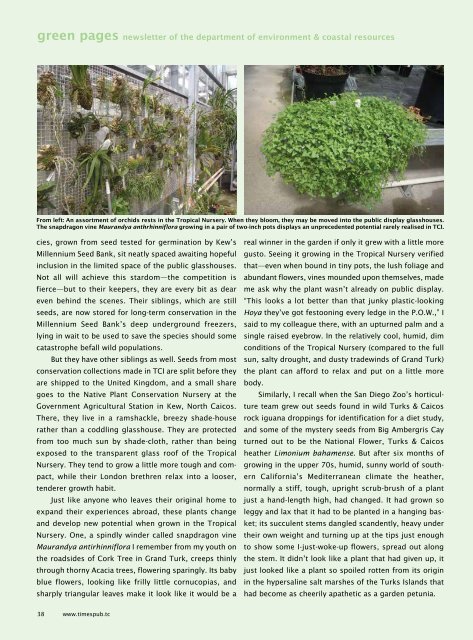Times of the Islands Spring 2017
Presents the "soul of the Turks & Caicos Islands" with in-depth features about local people, culture, history, environment, businesses, resorts, restaurants and activities.
Presents the "soul of the Turks & Caicos Islands" with in-depth features about local people, culture, history, environment, businesses, resorts, restaurants and activities.
Create successful ePaper yourself
Turn your PDF publications into a flip-book with our unique Google optimized e-Paper software.
green pages newsletter <strong>of</strong> <strong>the</strong> department <strong>of</strong> environment & coastal resources<br />
From left: An assortment <strong>of</strong> orchids rests in <strong>the</strong> Tropical Nursery. When <strong>the</strong>y bloom, <strong>the</strong>y may be moved into <strong>the</strong> public display glasshouses.<br />
The snapdragon vine Maurandya anthrhinniflora growing in a pair <strong>of</strong> two-inch pots displays an unprecedented potential rarely realised in TCI.<br />
cies, grown from seed tested for germination by Kew’s<br />
Millennium Seed Bank, sit neatly spaced awaiting hopeful<br />
inclusion in <strong>the</strong> limited space <strong>of</strong> <strong>the</strong> public glasshouses.<br />
Not all will achieve this stardom—<strong>the</strong> competition is<br />
fierce—but to <strong>the</strong>ir keepers, <strong>the</strong>y are every bit as dear<br />
even behind <strong>the</strong> scenes. Their siblings, which are still<br />
seeds, are now stored for long-term conservation in <strong>the</strong><br />
Millennium Seed Bank’s deep underground freezers,<br />
lying in wait to be used to save <strong>the</strong> species should some<br />
catastrophe befall wild populations.<br />
But <strong>the</strong>y have o<strong>the</strong>r siblings as well. Seeds from most<br />
conservation collections made in TCI are split before <strong>the</strong>y<br />
are shipped to <strong>the</strong> United Kingdom, and a small share<br />
goes to <strong>the</strong> Native Plant Conservation Nursery at <strong>the</strong><br />
Government Agricultural Station in Kew, North Caicos.<br />
There, <strong>the</strong>y live in a ramshackle, breezy shade-house<br />
ra<strong>the</strong>r than a coddling glasshouse. They are protected<br />
from too much sun by shade-cloth, ra<strong>the</strong>r than being<br />
exposed to <strong>the</strong> transparent glass ro<strong>of</strong> <strong>of</strong> <strong>the</strong> Tropical<br />
Nursery. They tend to grow a little more tough and compact,<br />
while <strong>the</strong>ir London brethren relax into a looser,<br />
tenderer growth habit.<br />
Just like anyone who leaves <strong>the</strong>ir original home to<br />
expand <strong>the</strong>ir experiences abroad, <strong>the</strong>se plants change<br />
and develop new potential when grown in <strong>the</strong> Tropical<br />
Nursery. One, a spindly winder called snapdragon vine<br />
Maurandya antirhinniflora I remember from my youth on<br />
<strong>the</strong> roadsides <strong>of</strong> Cork Tree in Grand Turk, creeps thinly<br />
through thorny Acacia trees, flowering sparingly. Its baby<br />
blue flowers, looking like frilly little cornucopias, and<br />
sharply triangular leaves make it look like it would be a<br />
real winner in <strong>the</strong> garden if only it grew with a little more<br />
gusto. Seeing it growing in <strong>the</strong> Tropical Nursery verified<br />
that—even when bound in tiny pots, <strong>the</strong> lush foliage and<br />
abundant flowers, vines mounded upon <strong>the</strong>mselves, made<br />
me ask why <strong>the</strong> plant wasn’t already on public display.<br />
“This looks a lot better than that junky plastic-looking<br />
Hoya <strong>the</strong>y’ve got festooning every ledge in <strong>the</strong> P.O.W.,” I<br />
said to my colleague <strong>the</strong>re, with an upturned palm and a<br />
single raised eyebrow. In <strong>the</strong> relatively cool, humid, dim<br />
conditions <strong>of</strong> <strong>the</strong> Tropical Nursery (compared to <strong>the</strong> full<br />
sun, salty drought, and dusty tradewinds <strong>of</strong> Grand Turk)<br />
<strong>the</strong> plant can afford to relax and put on a little more<br />
body.<br />
Similarly, I recall when <strong>the</strong> San Diego Zoo’s horticulture<br />
team grew out seeds found in wild Turks & Caicos<br />
rock iguana droppings for identification for a diet study,<br />
and some <strong>of</strong> <strong>the</strong> mystery seeds from Big Ambergris Cay<br />
turned out to be <strong>the</strong> National Flower, Turks & Caicos<br />
hea<strong>the</strong>r Limonium bahamense. But after six months <strong>of</strong><br />
growing in <strong>the</strong> upper 70s, humid, sunny world <strong>of</strong> sou<strong>the</strong>rn<br />
California’s Mediterranean climate <strong>the</strong> hea<strong>the</strong>r,<br />
normally a stiff, tough, upright scrub-brush <strong>of</strong> a plant<br />
just a hand-length high, had changed. It had grown so<br />
leggy and lax that it had to be planted in a hanging basket;<br />
its succulent stems dangled scandently, heavy under<br />
<strong>the</strong>ir own weight and turning up at <strong>the</strong> tips just enough<br />
to show some I-just-woke-up flowers, spread out along<br />
<strong>the</strong> stem. It didn’t look like a plant that had given up, it<br />
just looked like a plant so spoiled rotten from its origin<br />
in <strong>the</strong> hypersaline salt marshes <strong>of</strong> <strong>the</strong> Turks <strong>Islands</strong> that<br />
had become as cheerily apa<strong>the</strong>tic as a garden petunia.<br />
38 www.timespub.tc

















